#sexism and ageism
Text
Genuine question: where did the perception that fandom is for young people come from? When I first got into fandom it was mostly middle aged ladies. Fandom as we think of it today was invented by middle aged ladies; AO3 was invented by people who certainly weren't kids or teens.
Like I get there is both sexism and ageism involved--adult women aren't supposed to have hobbies etc etc, but presumably in, say, knitting fandom, the sexist and ageist comments aren't, "knitting is for young people and you're creepy to want to discuss knitting online." Presumably the vitriol is about wasting time or something, because as we all know the stereotype about knitting is that it's for little old ladies.
My question is how (and when) did the stereotype about fandom become that fandom is for young people?
1K notes
·
View notes
Text
This post reminded me of it, but my partner has observed that in contemporary gender discourse, maleness is so linked to adulthood and femaleness is so linked to childhood, that there are no "boys" or "women," only "men" and "girls."
This isn't exactly new -- for as long as patriarchy has existed, women have been infantilized, and "adult woman" has been treated as something of an oxymoron. Hegemonic beauty standards for women emphasize youthfulness, if not actual neoteny, and older women are considered "too old" to be attractive without ever quite being old enough to make their own decisions. There may be cultural allowances for the occasional older "wise woman," but a "wise woman" is always dangerously close to being a madwoman, or a witch. No matter how wise a woman is, she is never quite a rational agent. As Hanna K put it, "as a woman you're always either too young or too old for things, because the perfect age is when you're a man."
But the framing of underage boys as "men" has shifted, depending on popular conceptualizations of childhood and gender roles. Sometimes children of any gender are essentially feminized and grouped with women (the entire framing of "women and children" as a category). In the U.S. in the 21st century, the rise of men's rights and aggressively sexist ideology has correlated with an increased emphasis on little boys as "men" -- thus slogans like "Teach your son to be a man before his teacher teaches him to be a woman."
Of course, thanks to ageism and patriarchy (which literally means, not "rule by men," but "rule by fathers"), boys don't get any of the social benefits of being considered "men." They don't get to vote, make their own medical decisions, or have any of their own adult rights. They might have a little more childhood freedom than girls, if they're presumed to be sturdier and less vulnerable to "predators," but, for the most part, being considered "men" as young boys doesn't really get boys any more access to adult rights. What it does get them is aggressively gender-policed, often with violence. A little boy being "a man" means that he's not allowed to wear colors, have feelings, or experience the developmental stages of childhood.
This shifts in young adulthood, as boys forced into the role of "manhood" become actual men. As I've written about, I believe the trend of considering young adults "children" is harmful to everyone, but primarily to young women, young queer and trans people, and young disabled people. Abled, cisgender, heterosexual young men are rarely denied the rights and autonomy of adulthood due to "brain maturity."
What's particularly interesting is that, because transphobes misgender trans people as their birth-assigned genders, they constantly frame trans girls as "men" and trans men as "girls." A 10 year old trans girl on her elementary school soccer team is a "MAN using MAN STRENGTH on helpless GIRLS," while a 40 year old trans man is a "Poor confused little girl." Anyone assigned male at birth is born a scary, intimidating adult, while anyone female assigned at birth never becomes old enough to make xyr own decisions.
Feminist responses have also really fluctuated. Occasionally, feminists have played into the idea of little boys as "men," especially in trans-exclusionary rhetoric, or in one notorious case where members of a women's separatist compound were warned about "a man" who turned out to be a 6-month-old infant. There's periodic discourse around "Empowering our girls" or "Raising our boys with gentle masculinity," but for the most part, my problem with mainstream feminist rhetoric in general is that it tends to frame children solely as a labor imposed on women by men, not as subjects (and specifically, as an oppressed class) at all.
Second-wave feminists pushed back hard on calling adult women "girls" -- but they didn't necessarily view "women" as capable of autonomous decision-making, either. Adult women were women, but they might still need to be protected from their own false consciousness. As laws in the U.S., around medical privacy and autonomy, like HIPAA, started more firmly linking the concepts of autonomy with legal adulthood, and fixing the age of majority at 18, third-wave feminists embraced referring to women as "girls." Sometimes this was in an intentionally empowering way ("girl power," "girl boss"), which also served to shield women (mostly white, mostly bourgeois/wealthy) from criticism of their participation in racism and capitalism. But it also served to reinforce the narrative of women as "girls" needing to be protected from "men" (and their own choices).
I'm still hoping for a feminist politic that is pro-child, pro-youth, pro-disability, pro-autonomy, pro-equality, that rejects the infantilization of women, the adultification of boys, the objectification of children, the misgendering of trans people, and the imposition of gender roles.
660 notes
·
View notes
Text
Identifying as.

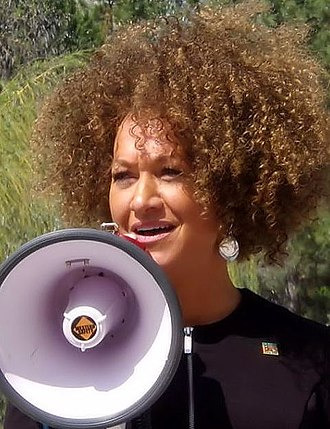
This is Rachel Dolezal, who legally changed her name to Nkechi Amare Diallo. Dolezal is a white woman who identifies as black and insists that she is transracial. Growing up, her religious white parents adopted four black babies, claiming that they "saved them from being aborted", and routinely delivered strict punishments to their kids including Dolezal. Dolezal does not seem to have a good relationship with her parents and, based on interviews, wanted to distance herself from them and distance herself from rural white culture.
"I've never questioned being a girl or woman, for example, but whiteness has always felt foreign to me, for as long as I can remember. I didn't choose to feel this way or be this way, I just am. What other choice is there than to be exactly who we are?"
She apparently "passed as black" for several years before her parents came out and said that she was white and is identifying as a black woman, and she was asked in a TV interview if she was African American and responded with "I don't understand the question". She taught Africana Studies at Eastern Washington University. She crafted a fake story in growing up as black and has argued that she experiences race-based related hate crimes. She darkens her skin and gets perms and started using hair products she observed her adopted black sibling to use. She lied about her father being black and lied that her black adopted brother was her son.
I hope that as details of Dolezal's story are read about, we are able to understand that tanning white skin does not make someone a black person, that blackface is wrong and racist. I hope we recognize that what makes someone black isn't a collection of racial stereotypes, isn't based on feeling a kinship with black people more than with white people, and that being black isn't based on not feeling a connection with white culture. I hope we understand that a black person cannot identify out of racial oppression, and that a white person cannot identify out of white privilege.

Jewel Shuping, age 38 now, was born healthy but dreamed of being blind since age 13. She stated her mother would tell stories about finding her walking down dark hallways at age 3, and mentioned that by age 6 the thought of being blind comforted her. When she was a teenager, Shuping bought a white cane and learned to read braille, becoming fluent in it by age 20.
She claims to have asked a psychologist to pour bleach in her eyes so she could fulfill her lifelong dream of being blind, and that the psychologist "understood her" and agreed to do so after giving her numbing eye drops to help with the pain (which was not ultimately helpful). She deliberately waited to seek medical attention so doctors were unable to save her eyesight. Gradually, over the course of six months, she became blind.
What Shuping has is considered a real mental health condition called Body Integrity Identity Disorder (BIID), a rare condition in which people who are born without disabilities believe with conviction that the should be disabled. There is another name for this in political activist circles, termed "transableism".
"I went blind on purpose, but I don't feel it was a choice."
Several other people with BIID are pretending to be paralyzed to use wheelchairs, with many not being driven to the point of causing harm to themselves to become disabled but instead living full lives faking being disabled.
I hope that as details of the stories of people pretending to be disabled are read about, we are able to understand that feeling like oneself should be disabled is an incredibly serious mental health condition and does not really mean that a person is "disabled inside". I hope we recognize that identifying as disabled does not make someone disabled, and that feeling a kinship with disabled people or a comfort in the thought of being disabled does not mean a person truly is or should become disabled. I hope we understand how people with mental health disorders claiming to be disabled can place further strain on resources and accommodations provided to disabled people. I hope we understand that inflicting pain, disfigurement, or physical altercations on healthy people to "help them physically match how they feel" is an inhumane way to treat a mental health condition.


Paul Wolscht, who changed his name to Stefonknee Wolscht, was married to a woman for over 20 years and fathered 7 children before deciding to live life identifying as a six year old little girl. Living as a six year old little girl allows Wolscht to escape depression and suicidal thoughts because Wolscht gets to now play - even when in jail in solitary confinement for nine days for an undisclosed reason.
“If I’m six-years-old, I don’t have to think about adult stuff.”
Wolscht still drives and drinks coffee, but does so feeling and identifying as a six year old.
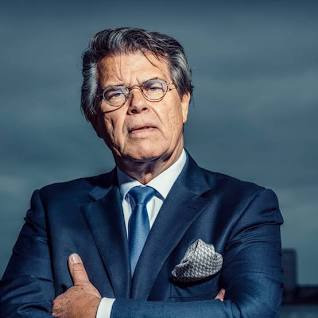
Emile Ratelband, age 69, petitioned the courts to allow him to change his age to 20 years younger because he "does not feel" 69 years old. Ratelband has argued that he did not feel comfortable with his date of birth, that age 69 did not accurately reflect his mental state, and that at age 69 he experiences limits.
“When I’m 69, I am limited. If I’m 49, then I can buy a new house, drive a different car,” he said. “I can take up more work. When I’m on Tinder and it says I’m 69, I don’t get an answer. When I’m 49, with the face I have, I will be in a luxurious position.”
Ratelband even asserted that doctors have told him he has the body of a man 20 years younger, and he said that he was willing to renounce his right to a pension. He argues that if people are able to legally change their sex on documents, there is no reason why he should not be able to change his age.
I hope that as we read these stories of people identifying as a different age, we are able to understand that feeling like you are 20 years younger or 40 years younger does not really make you that age. I hope that we understand that even though identifying as a different age might help avoid suicidal thoughts, being discriminated against on dating apps, or denied resources, it does not really change biologically what is. I hope we understand that there are also broader societal and legal consequences to being able to legally change one's age. That an adult might identify as a certain age to trick kids into trusting them so they can sexually abuse them, and/or that allowing an adult to legally consider themselves a different age would make it easier for adult predators to gain legal access to kids in environments in which they would normally be socially and legally discouraged from being in.
#trans#trans identity#transgender#trans pride#trans people#LGBTQ#lgbtq community#gender#transage#transabled#transracial#racism#ageism#sexism#ableism#disability rights#gay rights#LGB#women's rights#elder rights#mental health
828 notes
·
View notes
Text
Hate the chokehold anglicisms have even on formal German speech rn. Homies you need to STOP adding in so much random English or ur gonna reinvent Dutch at this rate 😭
#just read the word “Ageism“ in a German sentence#capitalized of course because that's what you do with nouns in this language. WHY NO TRANSLATION THOUGH#if racism -> Rassismus and sexism -> Sexismus then why not ageism -> Alterismus or something??#u sound ridiculoussss#german stuff
67 notes
·
View notes
Text

Every time I see a tweet like this I think to myself that She’s literally a walking stereotype of multiple harmful tropes. It’s so obvious growing up that she is. What the hell were the writers thinking?
145 notes
·
View notes
Text
Since there's a new PPG in development from Craig (which I hope actually HAPPENS considering WB now), and a CERTAIN PPG voice turned out to be a horrible person...if Bubbles gets recast I can totally hear Kimiko Glenn doing her voice. Izzy Moonbow from the new MLP movie reminded me so much of Bubbles anyway. I love her voice.
#powerpuff girls#no i don't want her 2016 voice back for two reasons#1. craig was againt the 2016 series anyway and all three girls were only recast because ageism/sexism and behind their backs and#2. Points for TRYING but...her 2016 voice wasn't really acting as much as reading lines off the script and sounded inconsistant#could've just been bad direction though but you can tell craig wants to move as far from the reboot as possible#kira buckland would also make an adorable bubbles
19 notes
·
View notes
Text
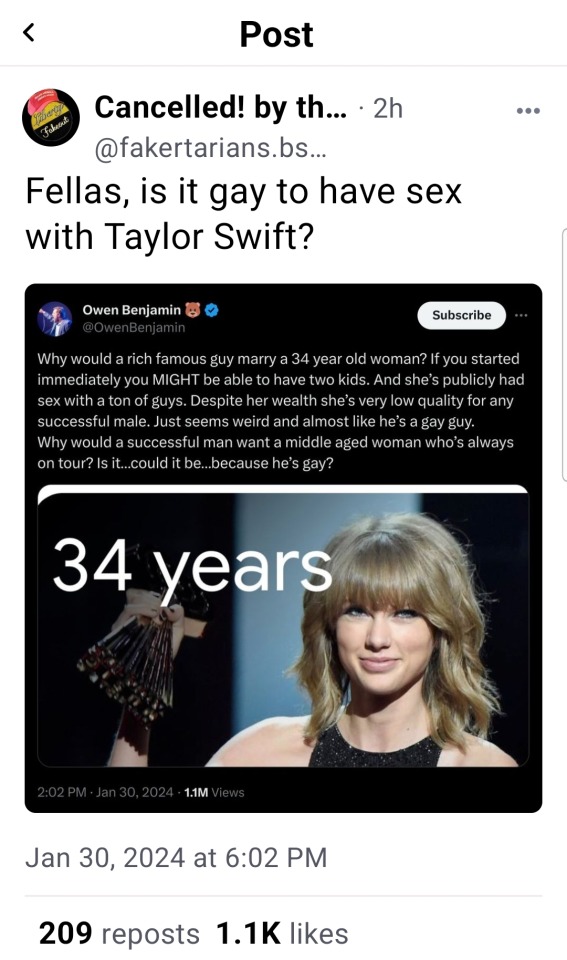
Babe wake up new tswift controversy just dropped
23 notes
·
View notes
Text
Age Discrimination Against Women Over 40 Happens In An Infuriating Way, Study Finds | HuffPost Life
Researchers Amy Diehl, Leanne M. Dzubinski and Amber L. Stephenson surveyed 913 women leaders who work in higher education, faith-based nonprofits, law, and health care with open-ended questions designed to uncover the different types of bias they may have experienced in their careers. The findings, which are undergoing peer review at a journal, show that gendered age biases are still alive and thriving in many workplaces.
What Diehl, Dzubinski and Stephenson discovered is that there is no mythical “prime” working age or “sweet spot” for professional women. Women under 40 in the study saw their experience and credibility dismissed because of their age, while women between 40 and 60 ― what the study considered middle age ― continued to experience gendered ageism, too.
“There was always an age-based excuse to not take women seriously, to discount their opinions, or to not hire or promote them,” the researchers wrote.
85 notes
·
View notes
Text

#intergenerational trauma#christofascists#christian supremacy#sexism#racisim#queerphobia#neurodiversity#ableism#leftism#mental illness#medical model#child trauma#ageism
14 notes
·
View notes
Text
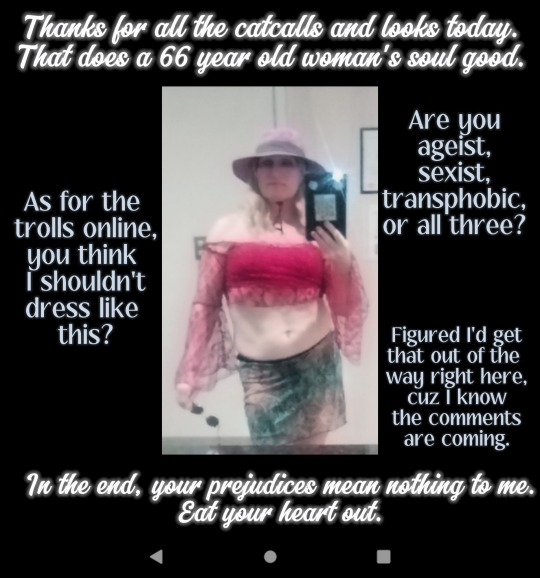
#transgender#trans woman#transisbeautiful#trans#trans pride#ageism#age is just a number#sexism#fypツ#fypシ#fyp
7 notes
·
View notes
Text
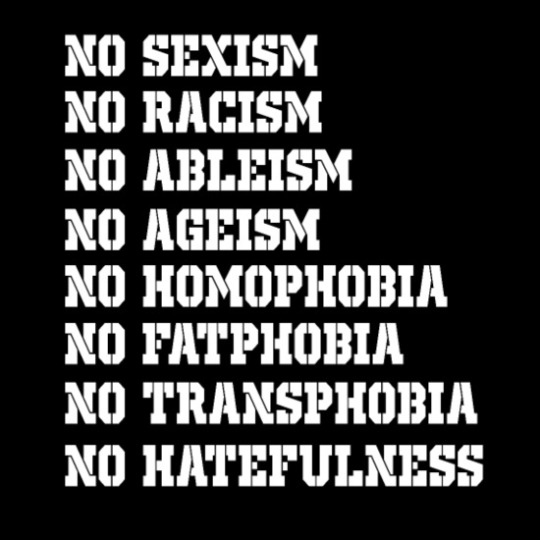
#equal rights#sexism#racism#ageism#homophobia#queerphobia#fatphobia#body shaming#transphobia#hatefulness#hate#love#lgbtq+#lgbt#intersectional feminism#ableism
9 notes
·
View notes
Text
Women are ... much more than men, expected to look younger than they are. As Susan Sontag wrote, in an essay called 'The Double Standard of Ageing', '[For women], only one standard of female beauty is sanctioned: the girl. The great advantage men have is that out culture allows two standards of male beauty: the boy and the man. The beauty of a boy resembles the beauty of a girl. In both, sexes it is a fragile kind of beauty and flourishes naturally only in the early part of the life-cycle. Happily, men are able to accept themselves under another standard of good looks – heavier, rougher, more thickly built. A man does not grieve when he loses the smooth, unlined, hairless skin of a boy. For he has only exchanged one form of attractiveness for another: the darker skin of a man's face, roughened by daily shaving, showing marks of emotions and the normal lines of age.
'There is no equivalent of this second standard for women. The single standard of beauty for women dictates that they must go one having clear skin. Every wrinkle, every line, every grey hair, is a defeat. No wonder that no boy minds becoming a man, while even the passage from girlhood to early womanhood is experienced by many women as their downfall, for all women are trained to continue wanting to look like girls.'
This has implications for how seriously women are take. Girls are taken less seriously than middle-aged women, yet middle-aged women are expected to do all they can do to look more like girls. As Elaine Chao put it to me, "There is much more pressure on older women to look younger than they are than there is for men. Which is horrible. It's a paradox. On the one hand, as we get older, we actually get wiser, more assertive, and more able to occupy equal footing. On the other hand, our looks work against us.' Mary Beard echoes this in Women and Power: 'Craggy or wrinkled faces signal mature wisdom in the case of a bloke, but "past-my-use-by-date" in the case of a woman.' No wonder over 90 per cent of Botox users and 92 per cent of cosmetic surgery patients are female.
– Mary Ann Sieghart (2021) The Authority Gap: Why Women are Still Taken Less Seriously Than Men and What We Can Do About It, pp. 250-1.
#mary ann sieghart#the authority gap#feminism#sexism#ageism#susan sontag#elaine chao#mary beard#beauty industry#lilac posts#another factor driving girls and young women towards transness
9 notes
·
View notes
Text

But "both sides". 🙄
#Israel#Palestine#Gaza#also if you feel like people are 'unfairly' centring women and children in discussions of the genocide#(which—for the record—I have not seen any of the pro-Palestine voices I follow do)#consider that women and children are making up the current known bulk of the casualties#consider that there may be a reason to centre them—especially the *children*#and again: it feels like—from my perspective—some of you are making up people to get mad at#especially given that we are hearing very little from Gaza proper#what with—y'know—the whole *complete destruction and control of the communications infrastructure* by Israel#but I digress#genocide tw#death tw#violence tw#murder tw#war tw#ageism mention#sexism mention#misogyny mention
10 notes
·
View notes
Note
Honestly, when I think about it, I kinda find Gothel prettier than Rapunzel. Mainly because she looks more like a real person with real, non-infantilized proportions(with limits, that is, this is a Disney cartoon, after all). While Rapunzel looks like a fucking baby stretched out to be the height of a teenager, not even that, but a preteen! And also because she has curly black hair, which I do too, so I find that really nice. Lastly, I feel like her color palette works better than Rapunzel’s, even though pink and purple are my favorite colors. The wine red looks very nice on her. However, I will admit that I am sort of hesitant to say this stuff because at the end of the day, Gothel is still an anti-Semitic caricature. Her Jewish features are there to remind the audience that she is evil. Not to make her more attractive, as opposed to Rapunzel and her button nose and long, straight, blonde hair(and for that matter, as a curly black-haired girlie, I HATE how the movie used curly black hair as a sign of villainy, deception, and evil and straight blonde hair as a sign of beauty, goodness, innocence, and magic, because holy fucking shit what the HECK were the writers thinking. Oh wait, never mind, I already know.) And in addition, most people who find Mother Gothel attractive sexualize her to hell and back, and that makes me very uncomfortable, whether she is a racist caricature or not. Not a fan. 🤮
I agree. I always thought that gothel looked better than rapunzel. Rapunzel’s design is so ugly to me. Her bug eyes, her very small waist and her big her head compared to the rest of her small body is not appealing to me. I also found the pink and purple color palette of her outfit to be so ugly and all over the place (even though purple is my favorite color). They ripped off Barbie as rapunzel’s dress but made it even more childlike and generic to appeal to young girls. Her design in the movie looks even worse now because the movie aged like milk. Rapunzel’s design looks way better hand drawn imo. At least gothel’s body looks like it belongs to a real life person and I found her to be pretty(even though she looks like and is a antisemitic caricature).
It’s just so depressing to me that they changed her original design from a white woman into a antisemitic caricature. Her original design looks nothing like that and she actually looked scary there. Even the original idea was that she looked like a normal and loving mother who would show her true colors through out the movie or so I heard. Just seeing that concept art of her taking rapunzel by force after rapunzel found out the truth about her looks so good. Then the writers just decided it would be easier to make her a caricature to show the difference between white rapunzel and her. They also thought her design should also be overly sexual to show how “pure and innocent” rapunzel and her mom look in comparison. It’s so disgusting. Whose bright idea was it to put this ageist, sexist and antisemitic shit in a Disney princess movie? I guess the same people who thought it would be best to release this movie one year after their first black princess movie.
What you said was so true. The curly hair being seen as bad to compared to the long blonde magical hair. Hell, even the decision to have rapunzel’s hair turn to brown after it was cut to show it lost its magic were all awful decisions. It’s like this movie was written in the 50s or something.
people who sexualize gothel are so weird. I don’t understand why people are like “she is so hot” towards people who have valid issues with her. It’s like they think it’s a compliment when it’s not.
26 notes
·
View notes
Text
In a group project for class made up of two women (including myself) and two men, we identified an area of a map online which seem to be populated by mostly women over 65 years of age. And my female classmate began joking around about "65+ Karens". This was a faceless polygon, all the information we had were things like age, sex, race, etc., and whether the area was highly polluted (and just to add, in comparison to its surrounding areas it was extremely high for a number of things like heavy metal contamination, etc.). It just made me sad. The devaluation of older women is so sad. We'll be these 65+ year old women some day if we're lucky.
Just makes me think of how the negative attitudes of older women prevents younger and more able women from advocating for human rights such as eldercare being female-focused (which will eventually effect us, again, if we're so lucky). It prevents us from forming solidarity and relationships with older women, and learning from them. It prevents the passing down of intergenerational knowlegde among women, learning about our female ancestors, etc. They're so wise and full of knowledge, yet diminished and treated as stupid or as male accessories.
I understand the commentary on class treatment in relation to sex, i.e. wealthy women treating poor and working class women poorly, but this isn't class analysis or commentary like people say it is, this is just a stereotype meant to destroy any kinship between older women and younger women.
#karen#gender#class#devaluation of women#women's oppression#feminism#intersectional feminism#feminist#misogyny#sexism#age#ageism
22 notes
·
View notes
Text
Hate when talented artists draw men of every shape and age and then have one staple young woman who can only get shorter or taller or have bigger boobs.
Ya'll need rehab.
4 notes
·
View notes